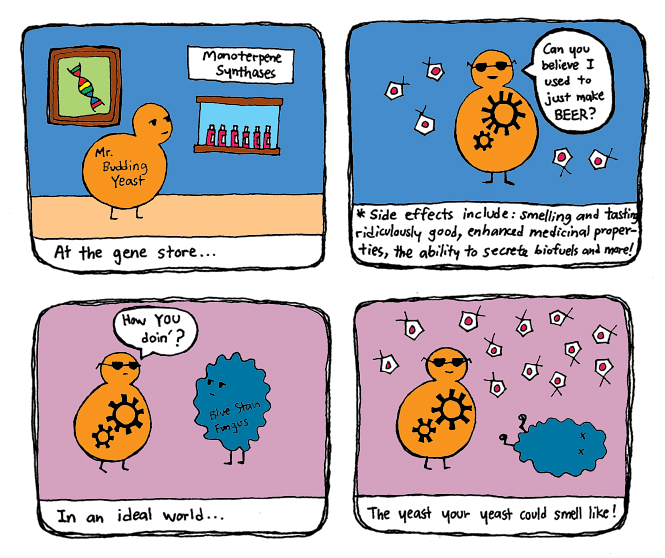Team:British Columbia/Objectives
From 2011.igem.org
| (3 intermediate revisions not shown) | |||
| Line 68: | Line 68: | ||
<Center><div id="header"><img style="margin-bottom:0px; margin-top:3px; margin-left: -5px; padding:0;" src="https://static.igem.org/mediawiki/2011/7/7a/Ubcigemhp.jpg" width=600px usemap="#hpheadermap" alt="UBC iGEM 2011 human practices header"> </div></center></html> | <Center><div id="header"><img style="margin-bottom:0px; margin-top:3px; margin-left: -5px; padding:0;" src="https://static.igem.org/mediawiki/2011/7/7a/Ubcigemhp.jpg" width=600px usemap="#hpheadermap" alt="UBC iGEM 2011 human practices header"> </div></center></html> | ||
| + | '''Mentorship''' | ||
| - | + | #Outreach at '''<html><a href="http://www.scienceworld.ca/">Science World</a></html>''': Start a high school iGEM team and mentor students participating in the '''<html><a href="http://www.scienceworld.ca/futurescienceleaders">Future Leaders in Science</a></html>''' program | |
| + | #Initiate collaboration with other iGEM teams to compile an <html><a href="http://openwetware.org/wiki/IGEM_Outreach:iGEM_Dictionary">iGEM dictionary</a></html> for synthetic biology and iGEM specific terms | ||
| - | + | '''Public Perceptions''' | |
| - | + | #Inform hundreds in the UBC student community about our project and iGEM at '''[http://www.students.ubc.ca/newtoubc/orientations.cfm?page=imagine Imagine Day Orientation]''' | |
| + | #Tracking changes in '''[https://2011.igem.org/Team:British_Columbia/Perceptions public perception]''' by asking for and collating definitions of synthetic biology each year at UBC | ||
| - | + | '''Synthetic Biology in the Wild''' | |
| + | #Conduct '''[https://2011.igem.org/Team:British_Columbia/Wild interviews]''' with experts in relevant fields to review the implications of introducing synthetic organisms into the environment | ||
| - | |||
| - | |||
| - | |||
| - | |||
| - | |||
| - | |||
| - | |||
| - | |||
| - | |||
| - | |||
| - | |||
| - | |||
| - | |||
| - | |||
<html><b><a href="https://2011.igem.org/Team:British_Columbia/HP">Multimedia and outreach details here!</b></a></html> | <html><b><a href="https://2011.igem.org/Team:British_Columbia/HP">Multimedia and outreach details here!</b></a></html> | ||
Latest revision as of 21:31, 21 October 2011

Wet Laboratory
Monoterpene Synthases
Our goal is to express synthases that produce monoterpenes (specifically limonene, pinene, carene and cineole) in yeast. Genes encoding these synthases will be inserted into yeast gateway vectors as well as the biobrick plasmid PSB1C3.
Metabolic Genes
Our goal is to express metabolic enzymes (specifically, erg20-2, Idi1 and Hmg2) that optimize the mevalonate pathway in yeast for monoterpene production.
Production of Monoterpenes in Yeast
From an industrial perspective, this yeast will be cultured and harvested for monoterpenes, which will be analysed by gas chromatography mass spectrometry (GC-MS). Yeast is a highly utilized organism in industry (e.g. breweries and also the recently established Amyris biotech company that uses yeast to produce anti-Malarial therapeutics amongst other valuable compounds). We envision that monoterpene-producing yeast will not only be industrially profitable, but also help to alleviate the unsustainable consumption of nature's resources in the quest for biofuels, pharmaceuticals, flavours/fragrances etc.
From an environmental perspective, this yeast will be co-cultured with the bluestain fungus to determine if monoterpene-producing yeast is able to inhibit the growth of the fungus. This yeast is also a biological system that can be screened for potential targets against the fungus. For instance, since the yeast is actively producing monoterpenes, it is possible to look for yeast that have particular mutations that cause increased intolerance against monoterpenes. These mutations will reveal potential strategies against the fungus.
Characterization details here!
Computational Modeling

Mountain Pine Beetle Epidemic
A mathematical model that can predict the dynamics of the mountain pine beetle populations in B.C. under the influence of our synthetic product. This model can be coupled with the strategic planning for future conservation initiatives.
Monoterpene Production in Yeast
A model that can assay the production of monoterpenes in our genetically engineered yeast cells given that they contain the metabolic genes IDI1, K6R-hmg2, erg20-2 and a monoterpene synthase.
Synthase Structure
A model that can determine monoterpene synthase product specificity and enzymatic activity based on amino acid sequence.
Human Practices

Mentorship
- Outreach at Science World: Start a high school iGEM team and mentor students participating in the Future Leaders in Science program
- Initiate collaboration with other iGEM teams to compile an iGEM dictionary for synthetic biology and iGEM specific terms
Public Perceptions
- Inform hundreds in the UBC student community about our project and iGEM at [http://www.students.ubc.ca/newtoubc/orientations.cfm?page=imagine Imagine Day Orientation]
- Tracking changes in public perception by asking for and collating definitions of synthetic biology each year at UBC
Synthetic Biology in the Wild
- Conduct interviews with experts in relevant fields to review the implications of introducing synthetic organisms into the environment
Multimedia and outreach details here!
 "
"
